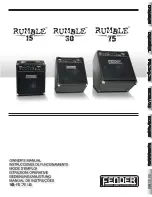
*
†
Assume temp =20
o
C, V
s
= 9V, unloaded output
CR-110
units
Preamplification channels
1
Equivalent noise charge (ENC)
*
ENC RMS
180
electrons
Equivalent noise in silicon
1.6
keV (FWHM)
2.1
keV (FWHM)
ENC slope
3
elect. RMS /pF
Gain
1.4
volts /pC
Rise time
†
7
ns
Decay time constant
140
s
Unsaturated output swing
volts
Maximum charge detectable per event
2.6 x10
7
electrons
4.2
pC
Output impedance
50
ohms
Power supply voltage (V
s
)
maximum
volts
volts
Power supply current
mA
V
s
= 13
V
s
= 6
-6 to +6
minimum
Equivalent noise in CdZnTe
CR-110 charge sensitive preamplifier: application guide
General Description
Cremat's CR-110 is a single channel, low noise charge sensitive
preamplifier intended for use with various types of radiation detectors
including semiconductor detectors, photomultiplier tubes (PMTs),
photodiodes, avalanche photodiodes (APDs), and various gas-based
detectors. The CR-110 is small (less than one square inch in area),
allowing for compact multichannel detection systems to be created
using a modular design. The CR-110 can provide equal performance
with pulses of either polarity.
Detector coupling
The CR-110 can be used either in a
direct coupled (DC) mode, or an
AC coupled mode. These configurations are discussed below. If the
detector current exceeds 10 nA, it is recommended that an AC
coupled mode be used to prevent the resulting DC offset of the
preamplifier output from saturating.
Direct coupled operation
The above figure illustrates a typical configuration in which the CR-110
preamplifier is used to readout a detector in a 'DC coupled'
configuration. Detector current flows directly into the preamplifier input,
which is held at approximately a couple tenths of a volt below ground
potential. Detector current also produces an offset in the preamplifier
output voltage at a rate of 0.2 V per nA. A DC coupled configuration is
recommended unless high detector current causes the DC level at the
output to saturate.
Bypassed (AC coupled) operation
In cases in which detector current exceeds approximately 10 nA, an
AC coupled configuration is recommended to prevent the DC level of
the output from saturating. The above figure shows the connections
typically made in such a situation.
Package Specifications
The CR-110 circuit is contacted via an 8-pin SIP connection (0.100"
spacing). Leads are 0.020 inches wide. Pin 1 is marked with a white
dot for identification.
Measured with input unconnected, using Gaussian shaping amplifier with time constant =1
s. With a detector attached to the input, noise from the detector capacitance, leakage
current, and dielectric losses will add to this figure.
Pulse rise time (defined as the time to attain 90% of maximum value) has a linear
relationship with input capacitance. Value cited in the table assumes zero added input
capacitance. To calculate pulse rise time for practical situations, use the equation: t
r
=0.4 C
d
+ 7 ns, where t
r
is the pulse rise time in ns, and C
d
is the added capacitance (e.g. detector
capacitance) in pF.
Equivalent circuit diagram
The figure below shows an simplified equivalent circuit diagram of the CR-110, which is a
two stage amplifier. The first stage is high gain, and the second stage is low gain with an
emphasis on supplying sufficient output current to drive a terminated coaxial cable.. Pin
numbers corresponding with the CR-110 preamplifier are shown. R
f
(100 M ) and C
f
(1.4 pF) are the feedback resistor and capacitor respectively.
Output offset
-0.5 to -0.1
0.03
femtoCoul.
volts
0.85"
0.88"
0.14"
CR-110
1 2 3 4 5 6 7 8
Figure 3.
input
GND
NC
GND
Vs
+Vs
NC
output
Cremat, Inc.
Operating temperature
-40 to +85
o
C
Figure 1.
output
filtered bias
Det bias
input
10M
0.01uF
detector
-Vpower
+Vpower
CR-110
1 2 3 4 5 6 7 8
Figure 2.
output
input
Det bias
CR-110
200M
10M
0.01uF
0.01uF
1 2 3 4 5 6 7 8
detector
+Vpower
-Vpower
Amplification polarity
inverting
Maximum output current (under load)
mA
70
1
8
6
2, 4
Cf
Rf
5
+
+
G= -20k
G=+2
Figure 4.
3, 7
NC
(GND)
11
Power dissipation
see Figure 7





















